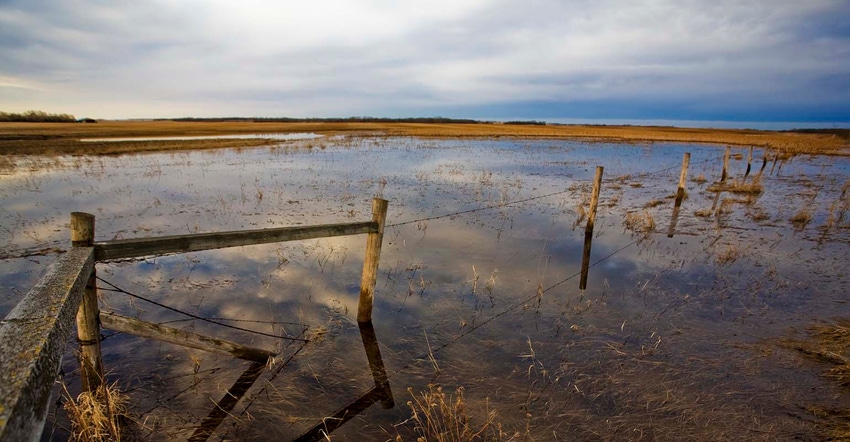
by Tatiana Freitas
The fields in Mato Grosso, Brazil’s top soybean producing state, have been so muddy that sometimes it’s almost impossible to walk through the rows of brown plants ready for harvest.
One week of persistent rain has soaked fields and caused beans to ferment and become engorged inside the pods, which have opened as the oilseeds also start to germinate. The damage was so bad that some farmers visited during an annual crop tour organized by Agroconsult, an agricultural forecaster, said that they’re getting paid only about a third of what they would if the season had been normal.
Mato Grosso is facing the wettest harvest in at least five years. The deluge has also given rise to weeds and insects, made harvesting more difficult and has the potential to boost transportation costs. While the supplies are still good enough for use in blends with undamaged crops, processors are paying farmers at a discount because of the quality issues.
That’s another blow to Brazilian producers who are already suffering through a multi-year drop in agriculture prices, currency appreciation and a recession in the nation. Soybean price to growers in Sorriso, a municipality in Mato Grosso, fell about 8 percent over the past year. Prices on the Chicago Board of Trade have climbed about 17% in the past 12 months.
Take the case of Ricardo Arioli, who planted 2,225 hectares (5,498 acres) with soybeans in the municipality of Campo Novo do Parecis. He delivered 480,000 kilograms (1,058,000 pounds) to a trading company that will process the crop into animal feed, or use it for export. His supplies were so damaged that he received payment for only 372,000 kilograms. Harvesting on his farm was halted for eight straight days amid the torrential rains, delaying gathering for 400 hectares that were ready for reaping.
Lost Production
“A significant part of the production is already lost,” Arioli said in an interview during the crop tour last week.
The story is being played out across fields in Mato Grosso, the tour showed. Sixteen participants, including agronomists, bankers and company representatives, trekked 10,000 kilometers (6,200 miles) around the state. The group was split into two routes: one traveled the state’s western and center regions, the other through the center and parts of the north. It was the 14th annual tour organized by Agroconsult.
While plenty of rain is needed during soybean growth, too much can lead to big problems for crop quality, including fermenting and germinating. Trading companies, which buy the soybeans, apply discounts on total delivery weight when damaged grains are equal to more than 8 percent of the cargo and the moisture level exceeds 14%.
Silvesio Oliveira, a farmer in the municipality of Tapurah, said that for one of his deliveries, beans were so damaged he was only paid for a third of the total weight.
The damaged oilseed can be blended with higher-quality crops, so the total production estimate for Mato Grosso should remain the same, according to Valmir Assarice, an analyst at Agroconsult. He expects soybean output could reach as high as 31 million tons, which would be a record. He estimates the country’s total crop at above 105 million tons.
Hurt Farmers
"Rains will hurt farmers’ profits because of the discounts applied, but will have minor impacts on crop volume," Assarice said on Feb. 17, after leading the company’s crop tour for four days.
Excessive rains may also increase producers’ expenses with transportation. Growers pay for freight from farms to traders’ storage facilities, a route that’s usually unpaved. Muddy conditions can stall and mire trucks, raising freight costs. The price of moving soybeans from Sorriso, a municipality where the crop is grown in Mato Grosso, across about 2,000 kilometers to the port of Santos, in Sao Paulo state, increased 53% since January 9 amid poor road conditions and increasing freight demand, according to Mato Grosso’s Rural Economy Institute.
When the beans have high-moisture levels, it also increases the time spent for drying resulting in long lines of trucks waiting to unload supplies that are still too soggy. That’s shrinking the number of vehicles available to take the soybeans out of farms. Arioli, the farmer from Campo Novo do Parecis, said he’s spent days waiting for trucks, and even offering extra compensation hasn’t eased the squeeze.
“Some deliveries are already late, and we’re warning traders that further delays may occur,” Arioli said.
To contact the reporter on this story: Tatiana Freitas in São Paulo at [email protected]
To contact the editors responsible for this story: Simon Casey at [email protected]
Millie Munshi, Robin Saponar
© 2017 Bloomberg L.P
About the Author(s)
You May Also Like




